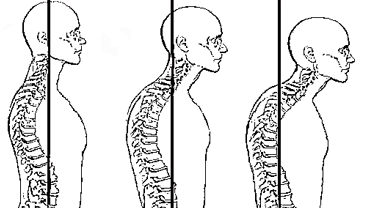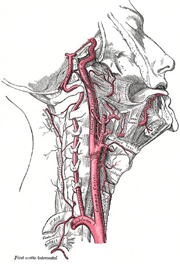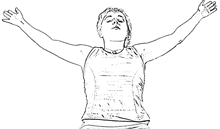Share
A forward head can be the root cause of all kinds of problems in the body, including headaches, jaw pain, neck and shoulder pain, and back pain.
 It makes good sense that the body works best if all the blocks are stacked up properly. Pelvis right over the legs instead of in front or behind, ribs over the pelvis instead of tilting backwards, and head over the ribs so the ear is lined up over the shoulder. Seems obvious, but most of us don’t seem to live there regularly.
It makes good sense that the body works best if all the blocks are stacked up properly. Pelvis right over the legs instead of in front or behind, ribs over the pelvis instead of tilting backwards, and head over the ribs so the ear is lined up over the shoulder. Seems obvious, but most of us don’t seem to live there regularly.
Our professions often mean that we are spending a lot of time sitting at desks looking at computers, which tends to pull our heads forward. We often relax by slumping into a sofa and watching TV, which curves our upper back, also bringing our head forward. Probably for most of us, we spend far more time sitting than standing.
Over time our postural habits “harden”. If we are constantly holding a particular posture and are not moving the body through the opposite range of motion, we will lost the motion we don’t use.
Soon we realize that we are uncomfortable lying on our back in our beds without that pillow, as to get our head to touch the mattress we would need to tip it way back, sticking our chin in the air, which might pull the mouth open making it uncomfortable to breathe. There is a huge gap between our neck and the bed. So we stuff a pillow in there so our face is parallel to the ceiling and we can be more comfortable.
But simple discomfort is not the only issue that a forward head can cause. As Paul Chek states, “For every inch that the head’s center of gravity is shifted forward, the lower cervical spine is subsequently subjected to compressive forces equivalent to a one-time additional weight of the head.”
Most heads weigh between 12 and 20 pounds, so if one's head were 3 inches forward, that would put between 36 and 60 pounds of extra weight on the lower cervical (neck) spine, which is extremely fatiguing to the muscles at the back of the neck.
The pull on the back of the head is also known to cause chronic headaches. These muscles that must deal with this constant load become exhausted, and their blood flow proportionally diminishes as the muscle contraction increases.
This lack of blood flow is often the primary source of muscle pain in the neck region. Releasing trigger points in the posterior neck muscles, especially splenius capitus, and the insertion points of levator scapula, traps, SCM and the occipital muscles can help, but unless one gets enough rest to allow blood-flow to return, the problem can become chronic.
Over time, the pain may migrate lower as more muscles become involved. As certain muscles tighten under the strain, their opposites lengthen and weaken, extending the problem further into the body.
For example, as the shoulder blades are pulled up to try and support the forward head, the muscles that pull the shoulder-blades down weaken.
In order to remain balanced in the standing position, we need to have our weight centered over our feet. So if the head is forward, the ribs tend to tilt back, and the pelvis will often tilt forward leading to problems in the lower back, hips and legs as well.
Because we need to keep our eyes level to the horizon in order to be able to see properly, as our head moves forward, it also tends to tilt backwards on the neck.
The area where the neck and cranium meet is a very busy place, and there should be a space of about 6.5 plus or minus 2.5mm between the base of the skull (occiput) and the 2nd vertebrae (spinous process of C2). When this space is reduced to 4mm or less, the nerves and blood vessels in that space can be mechanically compressed.
 When the back of the skull and the top vertebrae (OA joint) get too close together there is potential for compressing the vertebral artery and vein as they exit the transverse foramen of the top vertebrae to make their way into the cranium. Impaired blood flow into and drainage from the brain is never a good thing. (The vertebral artery is the thinner one at the back, threading through the holes in the vertebrae. This drawing is from Gray's Anatomy.)
When the back of the skull and the top vertebrae (OA joint) get too close together there is potential for compressing the vertebral artery and vein as they exit the transverse foramen of the top vertebrae to make their way into the cranium. Impaired blood flow into and drainage from the brain is never a good thing. (The vertebral artery is the thinner one at the back, threading through the holes in the vertebrae. This drawing is from Gray's Anatomy.)
This lack of space has been shown to be associated with higher incidence of vertigo (dizziness), possibly due to a compromised vertebral artery. If you notice you always get dizzy when you look up at the ceiling or airplanes in the sky, this is a warning sign that those blood vessels may be quite compromised and doing something to restore a better head position might improve the situation dramatically.
Besides blood vessels there are nerves that are in this tiny space as well. The greater occipital nerve itself can have a diameter as create as 3mm, so that does not leave much wiggle room. The nerve roots that exit from the top two vertebrae would be particularly vulnerable to mechanical forces due to forward-head posture.
Forward-head posture can create significant problems within the head too. Try sticking your head further forward, keeping your face looking straight ahead. Can you feel a stretch in the neck under your jaw? As the head goes forward, the jaw is often pulled back, which may altar one’s bite, leading to TMJ problems.
The hyoid bone in the front of the throat will be pulled up in forward-head posture, which may contribute to snoring and possibly even sleep apnea.
Notice also how as you push your head forward, your tongue drops a bit in your mouth, and as you pull your head back, more of your tongue contacts the roof of your mouth.
If your head is permanently forward and your tongue is lower in your mouth, this may encourage the habit of pushing the tongue against the front teeth with every swallow, eventually protruding those teeth forward impairing the bite.
Okay, I think I'll stop there. I won't go into the impact of forward head on the dura (fascia covering the spinal cord). I’m hoping it is clear that forward-head posture has a significant impact on the whole body, and that doing what is needed to bring the head back into its proper position can greatly improve pain syndromes and body function.
How far forward is your head? You can figure this out with a ruler and a plumb line (a piece of string with a key tied to the end), and a friend. Stand up, and put the ruler lightly in the sternoclavicular notch (the soft gushy V right above your breast bone at the bottom of your neck). Hold the string on the front of your cheek right on the bone, letting the plumb line hang, and have your friend read off the ruler how far forward your head is.
Might be more accurate if your friend does the whole thing, as often reaching your hands up towards your face will alter your normal head position.
Often awareness of body position can help, particularly when seated. Making sure one’s work environment is ergonomically correct is critically important.
The chair needs to be raised so that one can sit tall on the sit bones, shoulders resting on the ribs, elbows at 90 degrees. The monitor should be in front of the eyes, so the head does not need to be tilted down to view it. The feet should be resting on something that allows the ankles knees and hips to be at 90 degrees.
A good orthopaedic assessment can be helpful in determining the best approach to reducing forward-head posture. Sometimes it can be as simple as getting used to being in a different position – bringing the pelvis back over the legs, which would straighten the ribcage providing a upright platform for the head.
Most people would need a personalized stretching and strengthening program to bring the body back into alignment. For example, tight muscles at the pelvis will definitely impact head position, and which muscles need to be stretched and strengthened is a very individual thing.
In others, the upper back is stuck in too much curve, and the spinal segments would need to be mobilized the spinal and the back extensors would need to be strengthened.
 A simple stretch that can be done is to lie on the floor or in the middle of the bed on the back (use a small pillow if you need one), and reach the arms straight out to the side, slowly raising them up towards your head like a snow angel. When you start to feel a stretch, wait until the stretch dissipates. Do this daily. The goal is to have the upper arms resting on floor comfortably next to your ears without feeling any stretch at all.
A simple stretch that can be done is to lie on the floor or in the middle of the bed on the back (use a small pillow if you need one), and reach the arms straight out to the side, slowly raising them up towards your head like a snow angel. When you start to feel a stretch, wait until the stretch dissipates. Do this daily. The goal is to have the upper arms resting on floor comfortably next to your ears without feeling any stretch at all.
People with too much upper back roundness would probably also need stretching of the back of the neck and strengthening of the deep front neck muscles (longis colli and longis capitus). These neck muscles are tricky to strengthen without instruction, so seek out a CHEK Practitioner or physical therapist to help you.
If you are in the Vancouver area and would like help with this, please reply to this email. We would be happy to assess you and take you through an exercise program personally designed just for you. We also have gift certificates available if you want to give the gift of good posture and good movement to a friend or loved one.
If you want to share this article, scroll to the very bottom and click the “share” icon to post on Facebook, Twitter etc.
If you want to subscribe or search for other posts by title or by topic, go to www.wellnesstips.ca.
Related tips
Take your space and improve your posture
Whiplash, neck pain, and the muscles of the neck
Reduce neck strain
Respiration, the BIG boss
Chek, Paul
Posture and Craniofacial Pain 1994.
Gray, Henry Gray’s Anatomy: The Unabridged Running Press Edition Of The American Classic 1974.
Bradly K.C. The Posterior Primary Rami of Segmental Nerves, Aspects of Manipulative Therapy, Glascow, et al. Editors 1980: 59-64. Churchill Livingstone.
Walther DS AK Applied Kinesiology, Vol. 2: Head, Neck and Jaw Pain and Dysfunction, the Stomatognathic System 1983; 344-345. Systems D.C.
Rocobado M. Biomechanical Relationship of the Cranial, Cervical and Hyoid Regions. J Craniomandibular Pract. 1983 Jun-Aug;1(3):61-6.
Rocobado M. and S.A. Iglarsh. The Musculoskeletal Approach to Maxillofacial Pain
1991; 70. J.B. Lippincott Co.
Sjøgaard G, Kiens B, Jørgensen K, Saltin B. Intramuscular pressure, EMG and blood flow during low-level prolonged static contraction in man. Acta Physiol Scand. 1986 Nov;128(3):475-84.
Zohn D.A. Musculoskeletal pain : diagnosis and physical treatment 1988; 183-184, 186-187. Boston Toronto; Little Brown and Co.
Travell J.G. and D. Simons. Myofascial Pain and Dysfunction: The Trigger Point Manual (2-Volume Set) 1983: Willliams and Wilkins.
To subscribe go to www.wellnesstips.ca
 It makes good sense that the body works best if all the blocks are stacked up properly. Pelvis right over the legs instead of in front or behind, ribs over the pelvis instead of tilting backwards, and head over the ribs so the ear is lined up over the shoulder. Seems obvious, but most of us don’t seem to live there regularly.
It makes good sense that the body works best if all the blocks are stacked up properly. Pelvis right over the legs instead of in front or behind, ribs over the pelvis instead of tilting backwards, and head over the ribs so the ear is lined up over the shoulder. Seems obvious, but most of us don’t seem to live there regularly.  When the back of the skull and the top vertebrae (OA joint) get too close together there is potential for compressing the vertebral artery and vein as they exit the transverse foramen of the top vertebrae to make their way into the cranium. Impaired blood flow into and drainage from the brain is never a good thing. (The vertebral artery is the thinner one at the back, threading through the holes in the vertebrae. This drawing is from Gray's Anatomy.)
When the back of the skull and the top vertebrae (OA joint) get too close together there is potential for compressing the vertebral artery and vein as they exit the transverse foramen of the top vertebrae to make their way into the cranium. Impaired blood flow into and drainage from the brain is never a good thing. (The vertebral artery is the thinner one at the back, threading through the holes in the vertebrae. This drawing is from Gray's Anatomy.) A simple stretch that can be done is to lie on the floor or in the middle of the bed on the back (use a small pillow if you need one), and reach the arms straight out to the side, slowly raising them up towards your head like a snow angel. When you start to feel a stretch, wait until the stretch dissipates. Do this daily. The goal is to have the upper arms resting on floor comfortably next to your ears without feeling any stretch at all.
A simple stretch that can be done is to lie on the floor or in the middle of the bed on the back (use a small pillow if you need one), and reach the arms straight out to the side, slowly raising them up towards your head like a snow angel. When you start to feel a stretch, wait until the stretch dissipates. Do this daily. The goal is to have the upper arms resting on floor comfortably next to your ears without feeling any stretch at all.